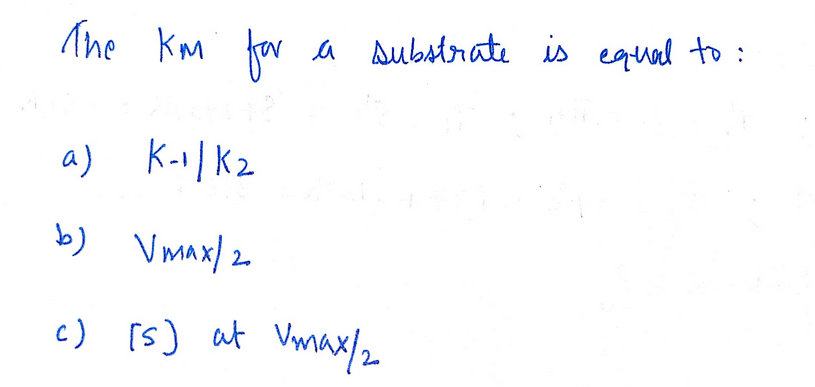Chemistry
10th Edition
ISBN:9781305957404
Author:Steven S. Zumdahl, Susan A. Zumdahl, Donald J. DeCoste
Publisher:Steven S. Zumdahl, Susan A. Zumdahl, Donald J. DeCoste
Chapter1: Chemical Foundations
Section: Chapter Questions
Problem 1RQ: Define and explain the differences between the following terms. a. law and theory b. theory and...
Related questions
Question
![### Understanding the Michaelis Constant (KM)
In the study of enzyme kinetics, the Michaelis constant (KM) for a substrate is a crucial parameter that defines the substrate concentration at which the reaction rate is at half of its maximum. This concept can be expressed in a few different ways:
a. **k-1/k2**: This option suggests a relation involving reaction rate constants. Typically, KM is more directly related to the breakdown and formation of enzyme-substrate complexes rather than a simple ratio of these constants.
b. **Vmax/2**: This option is incorrect as KM specifically refers to substrate concentration, not the velocity directly.
c. **[S] at Vmax/2**: This is the correct representation. KM is defined as the substrate concentration ([S]) at which the reaction velocity is half of Vmax (maximum velocity).
Understanding KM helps in determining the affinity of an enzyme for its substrate; a lower KM indicates a higher affinity, meaning less substrate is needed to reach half of the maximum reaction rate.](/v2/_next/image?url=https%3A%2F%2Fcontent.bartleby.com%2Fqna-images%2Fquestion%2Fe513d6b9-b548-4fc1-a571-93d4b3d9367d%2F2dec64ca-be04-45f5-8216-eee14f993cbb%2Fk2009er_processed.jpeg&w=3840&q=75)
Transcribed Image Text:### Understanding the Michaelis Constant (KM)
In the study of enzyme kinetics, the Michaelis constant (KM) for a substrate is a crucial parameter that defines the substrate concentration at which the reaction rate is at half of its maximum. This concept can be expressed in a few different ways:
a. **k-1/k2**: This option suggests a relation involving reaction rate constants. Typically, KM is more directly related to the breakdown and formation of enzyme-substrate complexes rather than a simple ratio of these constants.
b. **Vmax/2**: This option is incorrect as KM specifically refers to substrate concentration, not the velocity directly.
c. **[S] at Vmax/2**: This is the correct representation. KM is defined as the substrate concentration ([S]) at which the reaction velocity is half of Vmax (maximum velocity).
Understanding KM helps in determining the affinity of an enzyme for its substrate; a lower KM indicates a higher affinity, meaning less substrate is needed to reach half of the maximum reaction rate.
Expert Solution
Step 1

Step by step
Solved in 2 steps with 2 images

Knowledge Booster
Learn more about
Need a deep-dive on the concept behind this application? Look no further. Learn more about this topic, chemistry and related others by exploring similar questions and additional content below.Recommended textbooks for you

Chemistry
Chemistry
ISBN:
9781305957404
Author:
Steven S. Zumdahl, Susan A. Zumdahl, Donald J. DeCoste
Publisher:
Cengage Learning

Chemistry
Chemistry
ISBN:
9781259911156
Author:
Raymond Chang Dr., Jason Overby Professor
Publisher:
McGraw-Hill Education

Principles of Instrumental Analysis
Chemistry
ISBN:
9781305577213
Author:
Douglas A. Skoog, F. James Holler, Stanley R. Crouch
Publisher:
Cengage Learning

Chemistry
Chemistry
ISBN:
9781305957404
Author:
Steven S. Zumdahl, Susan A. Zumdahl, Donald J. DeCoste
Publisher:
Cengage Learning

Chemistry
Chemistry
ISBN:
9781259911156
Author:
Raymond Chang Dr., Jason Overby Professor
Publisher:
McGraw-Hill Education

Principles of Instrumental Analysis
Chemistry
ISBN:
9781305577213
Author:
Douglas A. Skoog, F. James Holler, Stanley R. Crouch
Publisher:
Cengage Learning

Organic Chemistry
Chemistry
ISBN:
9780078021558
Author:
Janice Gorzynski Smith Dr.
Publisher:
McGraw-Hill Education

Chemistry: Principles and Reactions
Chemistry
ISBN:
9781305079373
Author:
William L. Masterton, Cecile N. Hurley
Publisher:
Cengage Learning

Elementary Principles of Chemical Processes, Bind…
Chemistry
ISBN:
9781118431221
Author:
Richard M. Felder, Ronald W. Rousseau, Lisa G. Bullard
Publisher:
WILEY